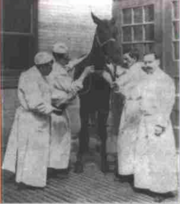
The horse named Jim
Encyclopedia

Blood plasma
Blood plasma is the straw-colored liquid component of blood in which the blood cells in whole blood are normally suspended. It makes up about 55% of the total blood volume. It is the intravascular fluid part of extracellular fluid...
containing antibodies
Antibody
An antibody, also known as an immunoglobulin, is a large Y-shaped protein used by the immune system to identify and neutralize foreign objects such as bacteria and viruses. The antibody recognizes a unique part of the foreign target, termed an antigen...
against diphtheria toxin
Diphtheria
Diphtheria is an upper respiratory tract illness caused by Corynebacterium diphtheriae, a facultative anaerobic, Gram-positive bacterium. It is characterized by sore throat, low fever, and an adherent membrane on the tonsils, pharynx, and/or nasal cavity...
. Jim produced over 30 quarts of diphtheria antitoxin
Antitoxin
An antitoxin is an antibody with the ability to neutralize a specific toxin. Antitoxins are produced by certain animals, plants, and bacteria. Although they are most effective in neutralizing toxins, they can kill bacteria and other microorganisms. Antitoxins are made within organisms, but can be...
in his career, and no doubt saved many lives. However, on October 2, 1901 Jim showed signs that he had contracted tetanus
Clostridium tetani
Clostridium tetani is a rod-shaped, anaerobic bacterium of the genus Clostridium. Like other Clostridium species, it is Gram-positive, and its appearance on a gram stain resembles tennis rackets or drumsticks. C. tetani is found as spores in soil or in the gastrointestinal tract of animals. C...
and was killed. After the death of a girl in St. Louis was traced back to Jim's contaminated serum, it was discovered that serum dated September 30th contained tetanus in its incubation phase. This could have easily been discovered, had the serum been tested prior to use. Furthermore, samples from September 30th had also been used to fill bottles labeled August 24th, while actual samples from the 24th were shown to be free of contamination.
These failures in oversight led to the distribution of antitoxin that caused the death of 12 more children. This incident, and a similar one involving contaminated smallpox
Smallpox
Smallpox was an infectious disease unique to humans, caused by either of two virus variants, Variola major and Variola minor. The disease is also known by the Latin names Variola or Variola vera, which is a derivative of the Latin varius, meaning "spotted", or varus, meaning "pimple"...
vaccine
Vaccine
A vaccine is a biological preparation that improves immunity to a particular disease. A vaccine typically contains an agent that resembles a disease-causing microorganism, and is often made from weakened or killed forms of the microbe or its toxins...
, led to the passage of the Biologics Control Act
Biologics Control Act
The Biologics Control Act was passed in the United States on July 1, 1902 after two incidents involving the deaths of children caused by contaminated vaccines. The first involved the horse named Jim whose tetanus-contaminated serum was used to produce a diphtheria antitoxin that caused the deaths...
of 1902 which established the Center for Biologics Evaluation and Research
Center for Biologics Evaluation and Research
The Center for Biologics Evaluation and Research is one of six main centers for the U.S. Food and Drug Administration , which is a part of the U.S. Department of Health and Human Services. The current Director of CBER is Dr. Karen Midthun, M.D...
. Jim's misfortune, and the ensuing tragedy and reaction thus set a precedent for regulation of biologics and set the stage for the formation of the Food and Drug Administration
Food and Drug Administration
The Food and Drug Administration is an agency of the United States Department of Health and Human Services, one of the United States federal executive departments...
(FDA).

